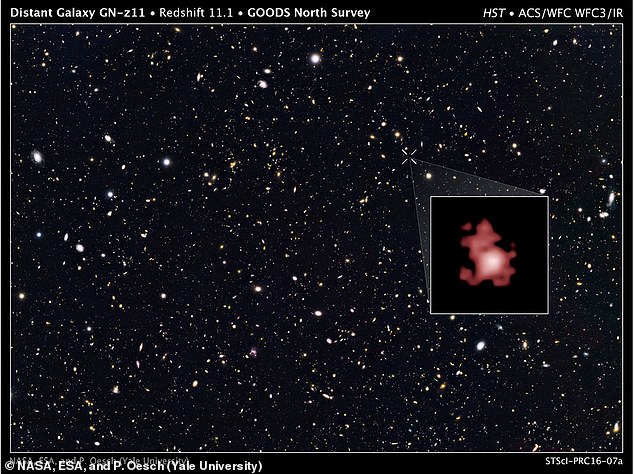NASA’s James Webb sees one of the universe’s very first galaxies that formed just 430 million years after the Big Bang — and astronomers reveal why it’s still so bright
NASA’s James Webb Space Telescope (JWST) has examined a galaxy that formed just 430 million years after the Big Bang.
If scientists are right, this galaxy is one of the very oldest galaxies in existence and could have been a nursery for ancient Population III stars – a holy grail of modern astronomy.
The galaxy, called GN-z11, has a supermassive black hole at its center that weighs the equivalent of 2 million suns.
The exceptional brightness comes from all the hot, heavy materials that the black hole sucks in.
This image comes from the James Webb Space Telescope’s NIRCam (Near-Infrared Camera). It shows part of the GOODS-North field of galaxies. At the bottom right, a crop highlights the galaxy GN-z11, visible just 430 million years after the Big Bang.
The JWST was launched in 2021 to capture the faintest light from distant stars.
This gives us a glimpse into the earliest days of our universe’s formation, about 13.8 billion years ago.
The new discovery suggests that the space telescope is well equipped to deliver on its promises.
The galaxy was first spotted by the Hubble Space Telescope in 2015.
GN-z11 is brighter than the other stars and galaxies nearby.
At the time, scientists could see that this was exceptional, but the Hubble Space Telescope wasn’t powerful enough to help them explain why.
Part of its brightness, astronomers now claim, is that the galaxy hosts a central, supermassive black hole that has two million times the mass of our Sun.
It rapidly accumulates matter, making the area around the black hole appear exceptionally bright.
GN-z11 is also the most distant supermassive black hole ever described by astronomers.

Galaxy GN-z11, shown in the inset, as it was first spotted in 2015 by the Hubble Space Telescope
“We found extremely dense gas that is common near supermassive black holes that suck in gas,” said lead scientist Roberto Maiolino, professor of experimental astrophysics at the University of Cambridge, in a rack.
“These were the first clear signs that GN-z11 harbors a matter-consuming black hole,” he said.
The JWST’s NIRCam (Near-Infrared Camera) located GN-z11 in the GOODS-North field of galaxies.
The new images from JWST may not seem to have the same level of detail as the 2015 Hubble image, but while Hubble captured ultraviolet light, JWST was able to image infrared.
Infrared is a type of light with a wavelength almost twice as long as ultraviolet. In this case it is important because there were some clues about GN-z11 that Hubble had missed because they could only be seen in infrared.
The NIRCam revealed ionized chemical elements, which are often the hallmark of supermassive black holes that gather material.
Along with this signature, the scientists also observed a strong “wind” blowing through the Milky Way at a speed of 800 to 1,000 kilometers per second (about 500 to 600 miles per second).
This is also a typical feature of a supermassive black hole, says co-author Hannah Übler.
“Webb’s NIRCam (Near-Infrared Camera) has revealed an extended component that tracks the host galaxy, and a central, compact source whose colors are consistent with those of an accretion disk around a black hole,” she said.
Taken together, these factors explained GN-z11’s unusual brightness.
Maiolino, Übler and their colleagues published their findings in the journal Nature.
Another team used the telescope’s NIRSpec (Near-Infrared Spectrograph) instrument to discover a clump of helium gas around the galaxy.
“The fact that we don’t see anything other than helium suggests that this clump must be fairly pristine,” says Maiolino.
‘This is something that was expected by theory and simulations near particularly massive galaxies from these epochs: that regions of pristine gas should survive in the halo, and that these could collapse and form Population III star clusters .’
Population III stars were some of the very first stars in the universe made of helium and hydrogen.
Based on the fact that the scientists observed helium and nothing else, they think they have found one of these holy grails of astronomy.

A small box identifies GN-z11 in a field of galaxies (top right). This can be seen zoomed in in the middle. The far left box shows the halo of helium gas around the galaxy, including a clump not visible in the infrared colors in the middle box. The graph at the bottom shows the clear light signature of helium and no other element. Scientists concluded that this must mean the helium lump is a pristine remnant of the Big Bang
These Population III stars formed around the transition point in the early universe, when it went from simplistic and disorderly to complex and ordered.
From the very first findings, astronomers have enthusiastically claimed that the JWST reveals details about the early universe that challenge our understanding of astrophysics.
However, not everyone agrees.
There may be simpler explanations than “everything we know is wrong,” according to a recent study study.
A team of researchers compared images taken by JWST with similar images captured by the older Hubble Space Telescope, and they concluded that it is not time to throw out the rules of astrophysics.
Instead, they suggest that the findings from both space telescopes are compatible, as long as scientists are willing to seek conventional explanations.
For example, they suggest that some yet-to-be-understood conditions in the early universe may have allowed brighter stars to form.
